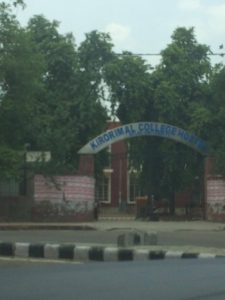DU Have What It Takes?
 Back home in the US, everyone complains about the college admissions process. Struggling through the clunky common app, mailing in the few hold-out paper applications and tactfully choosing one’s extracurriculars for maximum resume building has become a rite of passage, a pesky yet necessary step between teenagerdom and adulthood. We dutifully sit through the series of exams --- the APs, the SATs, and the ACTs --- as many times as it takes to get a score that’s “good enough.” And by April, seniors across the country breathe sighs of relief, with the mania of applications behind them, hopefully a few acceptances in their pockets, and their future stretching out unencumbered, straight ahead.
Back home in the US, everyone complains about the college admissions process. Struggling through the clunky common app, mailing in the few hold-out paper applications and tactfully choosing one’s extracurriculars for maximum resume building has become a rite of passage, a pesky yet necessary step between teenagerdom and adulthood. We dutifully sit through the series of exams --- the APs, the SATs, and the ACTs --- as many times as it takes to get a score that’s “good enough.” And by April, seniors across the country breathe sighs of relief, with the mania of applications behind them, hopefully a few acceptances in their pockets, and their future stretching out unencumbered, straight ahead.
In India, high school seniors are all but checked out by April. Having completed their boards in March, they have nothing to do but wait. For the bulk of students who choose to stay and pursue their higher education in the country, they won’t know what their future holds until June, maybe even July. If they’re lucky, they’ll end up at Delhi University.
Although located in the nation’s capital, the University is situated past Old Delhi and its winding roads with over arching canopies of trees. The campus doesn’t resemble much of the city I’ve become accustomed to, with billboards and precariously stacked storefronts replaced with neon-colored signs for “Girls PG” and walled institutions, crumbling yet stately all the same.
Composed of 16 faculties (like the Faculty of Law or Faculty of Arts) and 65 separate colleges (22 of which accept only women) split across two campuses, DU is known for its renowned faculty and high standards. And on June 30, the first day of admission for the 2016-2017 school year, I found myself bumping along in a rickshaw, drenched in sweat and getting properly lost at Delhi University’s North Campus in search of a story.
Although I had few delusions about the true campus nature of the University, I had imagined a more coherent collection of colleges, all lined up, one next to the other, with old-school gates and the traditional lawns. In reality, the university reminded me of ancient castles -- once bastions of the elite, now a bit worse for the wear. Gates there were plenty but only one of the four colleges I visited had the kind of lawns and outdoor beauty I’d imagined.
At the first stop, Ramjas College, we circled the entrance, weaving through the clumps of students gathered outside, ducking our heads to avoid making eye contact with the throngs of upperclassmen wearing lanyards that read “Can I help you?” The reporter with me was worried we would be labelled as press and not allowed inside, but I think I made a pretty believable prospective college student, if the number of flyers I was handed, advertising youth hostels for girls, is any indication.
Once inside, there were pony-tailed girls in kurtas and jeans, clutching their packet of documents nervously, chatting with their mothers, and boys with crisp shirts, acid washed jeans and slicked-back hair lining benches in the shade. And dozens more students sat in alcoves between the pillars that ringed the dirt-filled courtyard, staring up at the list of cutoffs posted outside classroom after classroom.
Last year, DU did the unthinkable, raising the initial cutoff for some of its colleges to 100%, meaning that even if a student got 99 on their boards, they wouldn’t be considered for the first round of admissions. The cutoff varies by college and then within the college per subject and category. Similar to the American system of affirmative action, each college has a quota of students from minority categories they must fill, so these students get priority or a lowered cutoff.
At St. Stephens, I met a girl from Kerala who’d been accepted into the college’s English honours programme. She’d received her admission earlier than most because she was a Christian. St. Stephens, as a Christian institution, had a separate stream of admission for Christian students. I understood then why someone had asked me if Jesuits or Catholic students got priority admission to schools like Georgetown, if their tuition fees were less because they were helping fulfill a quota. To me that was unthinkable, but here, it’s commonplace.
Passing the cutoff is not all you must do in order to gain acceptance at some of the more elite colleges within DU. Those require an in-person interview, a general aptitude test, and an entrance exam specific to the course/major you intend to pursue.
At Hindu College, we found more students studying for or waiting to take their entrance exam than we did accepted students. The air was thick with humidity and the nervous tension of students whose futures could be made or broken in the days to come.
How stressful it must be not knowing whether you’d even be going to college until weeks before the semester begins! The US system might be rigorous, but the Indian college application process is grueling. I’ll take a world full of meaningless extracurriculars and standardized tests over one where 99% might not be good enough, any day.
A version of this article appeared on the website of The Indian Express, and is available at http://indianexpress.com/article/blogs/delhi-univeristy-admissions-cut-offs-du-have-what-it-takes/.

